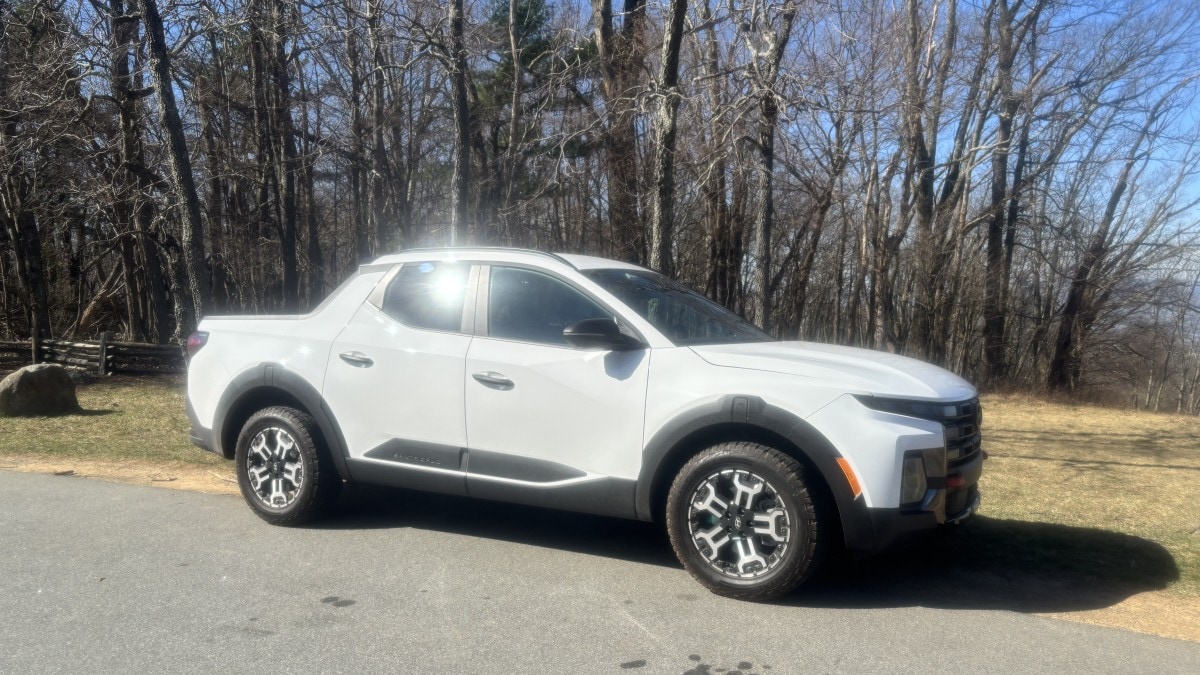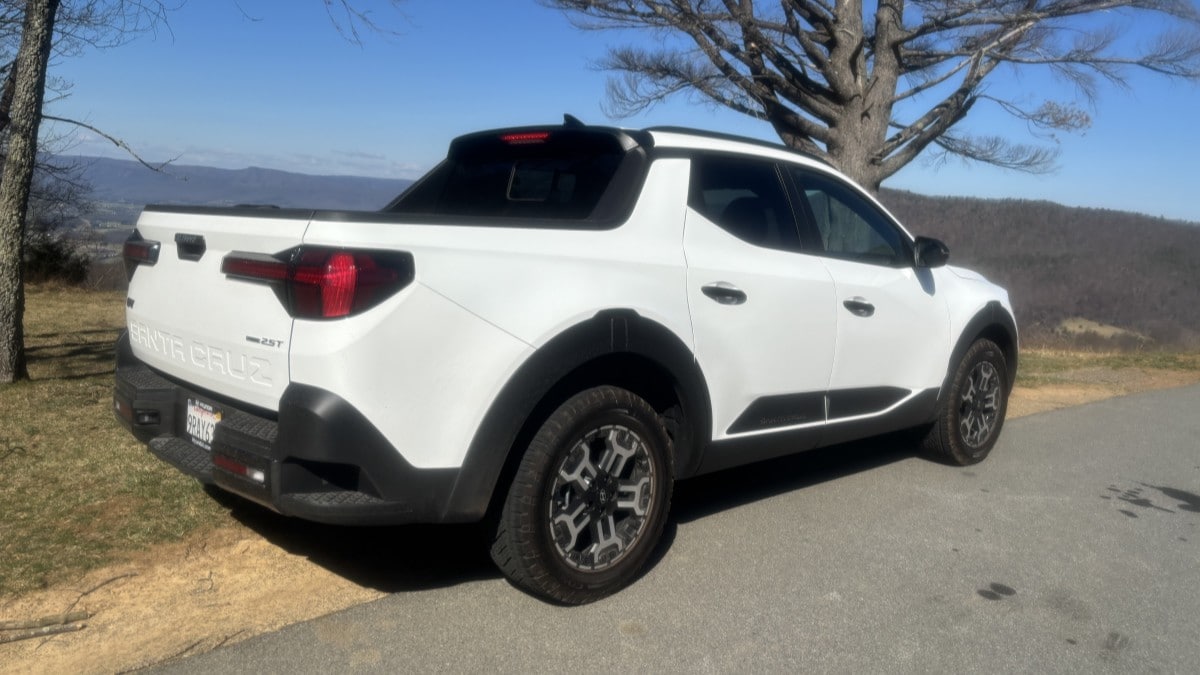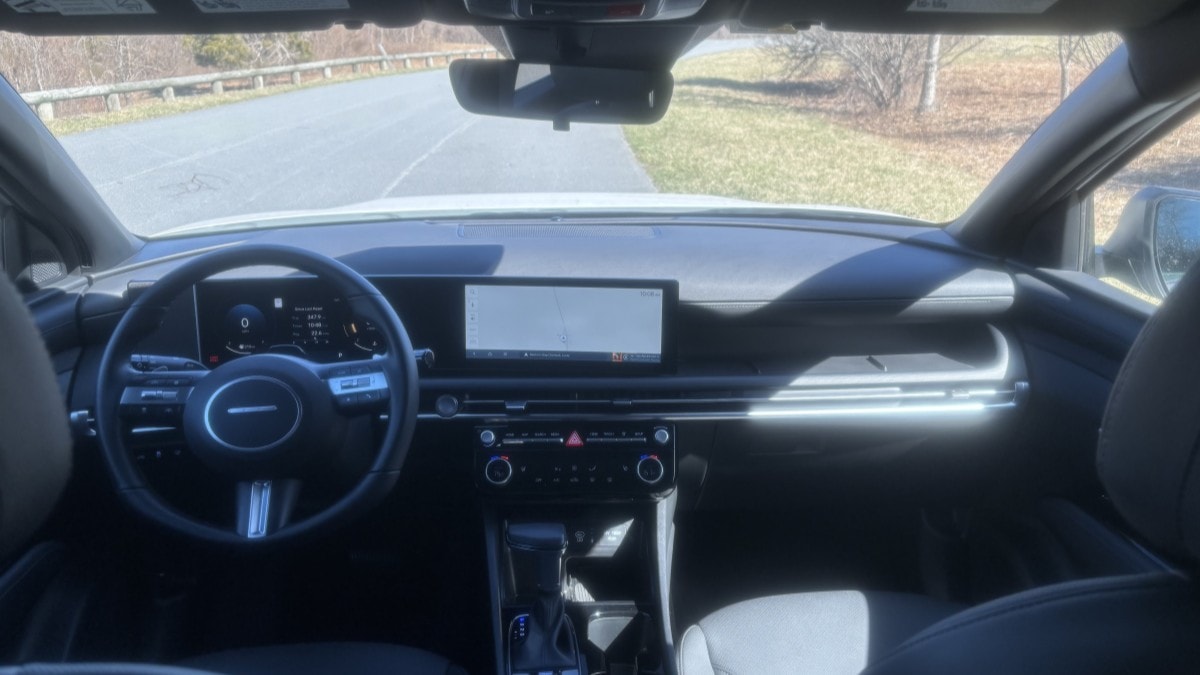I’m taking a long hairpin to the left, followed by a quick snap back to the right and a sudden climb up about 300 feet with a view of a long cascading stream to the right. The weather is perfect. My ride here is no sports car, but it’s handling with remarkable poise, and I’m pleasantly surprised at how nimble it’s proving to be … for a truck.
Is this a truck?
The 2025 Hyundai Santa Cruz rightfully slots into an in-between space between trucks and SUVs. It is perhaps the first trucklet to grace American roads in decades. And grace it has. Surprising grace here on the southern end of Skyline Drive, the 105-mile parkway through Virginia’s Blue Ridge Mountains.
There are countless curves and switchbacks here, and Hyundai’s genre-defying compact pickup slaloms through them with smoother athleticism than you’d expect from anything with a truck bed … even if it’s the smallest truck bed on the market today.
I’ll lay my cards on the table here. I wanted to like this car before it showed up for a week of testing. I’ve lamented the lack of small trucks on the American market for years, and love the thought of any truck small enough to parallel park easily in relatively urban spaces.
But I brought a healthy dose of skepticism, too, because this one stretches the definition of truck. It’s easy to climb inside, aerodynamic, and arguably just a Hyundai Tucson with the cargo area exposed to the elements. But the Santa Cruz won me over like few vehicles have.
My tester was the midlevel XRT trim, designed to be a bit more rugged than other trim levels. It has all-terrain tires and scratch-resistant fender cladding. It retails for $41,065, including a $1,395 destination fee and $210 for carpeted floor mats.


A Better Powertrain Than You’d Expect
Most trim levels of the Santa Cruz get a 4-cylinder engine making 191 horsepower and an 8-speed automatic transmission. That’s plenty for most people’s daily needs.
But the XRT and the top-of-the-line Limited model get a turbocharged 4-cylinder making 281 hp and a dual-clutch 8-speed automatic. Those 90 unnecessary hp give it a sporty edge I enjoyed in the mountains. I wouldn’t say every shopper should spring for the extra power. I would say you’ll enjoy having it if the added cost is easy for you to manage.
A small truck could still feel stiff and truckish if suspension engineers opted for the wrong setup. But the independent multi-link rear suspension here, not to mention the unibody design, makes the Santa Cruz handle like a sedan when the bed is empty. It coped easily with a load of mulch and kept its composure nearly the same. But a 1,411-pound payload capacity and a bed just 48 inches long mean this is a truck for weekend projects, not for serious contractor work.
That bed, however, hides one very cool trick: It has a lockable trunk under its floor.
Interestingly, there’s a button next to the shifter that looks like it activates a locking differential. The Santa Cruz doesn’t have one. Its all-wheel-drive (AWD) system can modulate torque application to each rear wheel separately to mimic the effects of one if you need extra grip in mud or on ice. It automatically deactivates once you’re traveling too fast to need it.


No Need to Look More Truckish Than It Is
A tiny bed. A light payload rating. A fake differential. It all sounds a little more truck-like than an actual truck, doesn’t it?
Hyundai designers leaned into that with the Santa Cruz. The little Hyundai doesn’t look much like a pickup. It’s closer to what the Australians call a ute, or the old Subaru Baja. Its flanks are rounded, its face aerodynamic and borrowed from the Tucson compact SUV.
The Santa Cruz has just one natural competitor: the Ford Maverick. Ford designers made the Maverick look like a shrunken version of that brand’s most capable trucks. Even as a lover of small pickups, I prefer the Hyundai approach.
The Santa Cruz’s truck-light look doesn’t overpromise.
Hyundai has also started to take more chances with color than most automakers. The rugged XRT trim is offered with only a black interior. But shoppers choosing other trim levels can select gray or even green leather.
Our XRT tester had Hyundai’s H-Tex faux leather, which does a convincing leather imitation and remains easy to clean. The ergonomics of the cabin are pleasant but unremarkable. For 2025, every Santa Cruz gets a pair of 12.3-inch touchscreens mounted together like one wide screen. It’s a neat look that feels of-the-moment. But I appreciate the physical buttons for HVAC controls and volume knob beneath.
Do not, however, begin thinking this truck is anything other than compact. The rear seats would not comfortably accommodate adults regularly. Hyundai gives them rear-seat vents, which Ford’s Maverick still lacks.


Where’s the Hybrid, Hyundai?
The Maverick has something the Santa Fe lacks, however — an optional hybrid powertrain.
This little truck rides on the same platform as the Tucson, which Hyundai offers in hybrid and plug-in hybrid form. That makes Hyundai’s choice not to build a Santa Cruz hybrid feel strange. They already have the parts they’d need to compete with the Ford in every way.
And if the Santa Cruz has a flaw, it’s less-than-stellar fuel economy. In XRT form, it gets just 21 mpg in combined driving. Other drivetrains do better — up to 25 mpg — but the 38 mpg of a Maverick hybrid puts it to shame.
That flaw aside, I thoroughly enjoyed my time in the Santa Cruz. I admittedly have an irrational affection for compact trucks. But I could see myself buying this — something I rarely say about the cars I test.
And, sure, part of that impression came from a perfect day on a winding road in the early spring woods. But that day would have been less pleasant in any other truck. Perhaps this pushes the boundaries of what counts as a truck. But that makes it unusually right for some of us.

